Donation request letters, whether sent via email or direct mail, are one of the most effective ways to reach donors and solicit gifts.
According to the Global Trends in Giving report, 33% of nonprofit supporters in the United States and Canada say email is the communication tool that inspires them most to give. Print communications came in second place, with 19% saying it was the most influential channel. Plus, 48% of respondents said regular email communication is the outreach method most likely to inspire recurring giving.
However, it’s not enough to simply send the same appeal to your entire supporter base and ask them to donate. Writing a compelling donation letter is an opportunity to engage your supporters and show them their impact on your mission. By personalizing your donation letters, your nonprofit can increase fundraising revenue and develop long-lasting supporter relationships.
Whether you’re just starting your donation letter strategy or seeking ways to improve it, it’s always a good idea to review the basics and ensure your communication strategies lay a solid foundation for growth. With that in mind, this guide is designed to help you craft engaging, inspirational donation request letters to send to supporters. We’ll cover:
- What is a donation request letter?
- How do you write a fundraising letter?
- Donation request letter example
- 12 fundraising letter templates
What is a donation request letter?
Donation request letters, also known as fundraising letters, ask for financial contributions from individual donors, corporate sponsors, and other supporters. These letters are particularly impactful during nonprofit giving days like GivingTuesday and targeted fundraising campaigns, providing a personal touch that can resonate with recipients.
Benefits of donation request letters

- Flexibility: Whether delivered through traditional direct mail or digital channels like email, donation request letters offer flexibility to suit different donors’ preferences.
- Versatility: While donation letters are commonly used to request financial contributions, it’s important to note that they can also effectively solicit in-kind donations, such as goods or services, from generous supporters. This versatility allows nonprofits to leverage donation letters across various fundraising initiatives, maximizing their outreach efforts and fostering greater community engagement.
- High return on investment (ROI): Studies have shown that direct mail campaigns can achieve a return on investment of up to 112%. Plus, these campaigns see average response rates of 5.3%.
Components of donation request letters
Before you start writing, here are some key elements you should include in your fundraising request letters:

- Introduction
- Success story
- The problem at hand
- Your solution
- Donation amount suggestion
- Impact statement
- How to donate
- Conclusion
- Contact information for someone at your organization
How do you write a fundraising letter? Key steps

1. Start with a personalized greeting.
The first thing that your donors look for is a personalized salutation, so begin your letters with a pleasant greeting and include your recipient’s name. Donation letters without names seem impersonal and are more likely to be ignored. One study found that emails including names in the salutation are 26% more likely to be opened.
It’s also important to include your organization’s logo on the letterhead so donors recognize who the letter is from and don’t throw it away.
2. Explain your mission.
If the recipient hasn’t heard of your organization, explain your mission at the beginning of your letter. This way, readers understand what you’re fighting for and the goals you want to accomplish.
One of the best ways to do this is by sharing a story about someone who’s benefited from your organization and how your donors helped make a difference in that person’s life. Storytelling connects donors to your mission and introduces them to the people they’ll help with their gifts.
3. Describe your current initiative.
You’re likely sending out donation letters for a specific reason, whether a project, campaign, or event. Describe that reason clearly and include key details like dates or guidelines. The story at the beginning of your donation letter will reinforce your appeal!
4. Outline your project’s needs and what you hope to accomplish.
Don’t forget to explain why it’s essential for your donors to support this project in your donation letters. How does it help them make a difference? Why should they give to this program in particular?
For instance, if you’re raising money to provide resources to schools worldwide, tell your donors what schools and communities their donations will support. Providing a compelling backstory helps you connect deeper with your prospective donors.
5. Add meaningful photographs or infographics.
Humans are visual creatures and often connect to a cause through visualizing it. Include photographs of your impact, especially photos featuring people you’ve helped! If your appeal is focused more on data, use infographics that show statistics to make important information easier to understand and highlight key points with bright colors to attract your donors’ attention. If you’re sending your letters via email, include a behind-the-scenes video.
6. Show the tangible impact associated with specific donation amounts.
Donors like knowing exactly where their money is going and how it will help make a difference. Within your donation letter, make a strong ask by describing specifically what their gifts will do. For example, stating that a donation of $100 provides a dog with food, shelter, and medicine helps your donors understand their impact. It may also inspire more generosity—they might increase their original $50 donation to $100!
7. Highlight past successes.
Share specific examples of how past donations have made a difference and contributed to the success of your organization’s projects or programs, if applicable. Demonstrating tangible outcomes and success stories can inspire confidence in potential donors and illustrate the impact of their contributions.
8. Include authentic testimonials or endorsements.
Incorporate testimonials from satisfied donors, volunteers, or community members to add credibility and authenticity to your donation request letter. Positive endorsements from individuals with firsthand experience with your organization can resonate with potential donors and reinforce the value of supporting your cause.
9. Make sure your letter is easy to read.
Your donation letters won’t have the desired effect if they’re unreadable. Choose your font and letter style carefully to guarantee your supporters can easily skim through your letter. Don’t use overly complicated language, either. Stick to an approachable tone and avoid jargon casual supporters may not understand.
10. Use a clear and direct call to action so readers know how they can give.
It’s essential to provide a clear and direct call to action (CTA) that guides donors on how they can give. Clarity is key, whether directing them to visit your website’s donation page, fill out and mail back a donation form, make a text donation, or call a designated phone number to contribute. By clearly outlining the steps donors need to take to support your cause, you remove any ambiguity and make it as easy as possible for them to act on their desire to make a difference.
Furthermore, creating a sense of urgency and importance around your call to action encourages supporters to contribute. Emphasize the immediate impact donors’ gifts will have and highlight any deadlines or matching gift opportunities.
11. Sign your name with any contact information and thank your reader for their future gift.
Express sincere gratitude to your donors for considering supporting your organization. Even if the primary purpose of your donation letter is to solicit a gift, taking the time to thank recipients for their attention and potential contribution demonstrates genuine appreciation for their support.
Additionally, ensure that your letter is signed personally, ideally by a member of your organization’s leadership or a recognizable figure associated with your cause. Including contact information, such as phone numbers, email addresses, website URLs, and social media handles, allows donors to easily reach out with any questions or concerns or to make their donation. Providing this accessibility reinforces transparency and trust, which are essential in fostering strong donor relationships.
12. Pick the perfect time to send your donation request letters.
Send a direct mail donation letter or email at the beginning of your campaigns. You don’t want to risk asking too late, as the recipient may not have enough time to make a gift before your campaign ends!
Donation request letter example
We’ve created this donation request letter example to give you a sense of how to format and design your printed donation request letters. This example incorporates all of the components and best practices listed above, including a suggested donation amount, ways to give, contact information for an individual in the organization, and an impact statement.

Based on your needs, you can adapt this formatting to the various letter templates in the next section.
12 fundraising letter templates
To help spark your creativity and speed up the letter-writing process, we’ve created the following donation request letter templates for common situations.
General donation request letter
What is a general donation request letter?
This template can be referenced for any type of fundraising effort. Use this simple donation letter sample for guidance to ensure you hit the most important points, but feel free to add your own spin to it to better connect with your audience.
To whom should you send general donation requests?
These letters are perfect for everyday fundraising campaigns and needs. You can send them to anyone in your support network, including current donors, prospective donors, corporate sponsors, board members, volunteers, event attendees, and more.
General donation request letter template
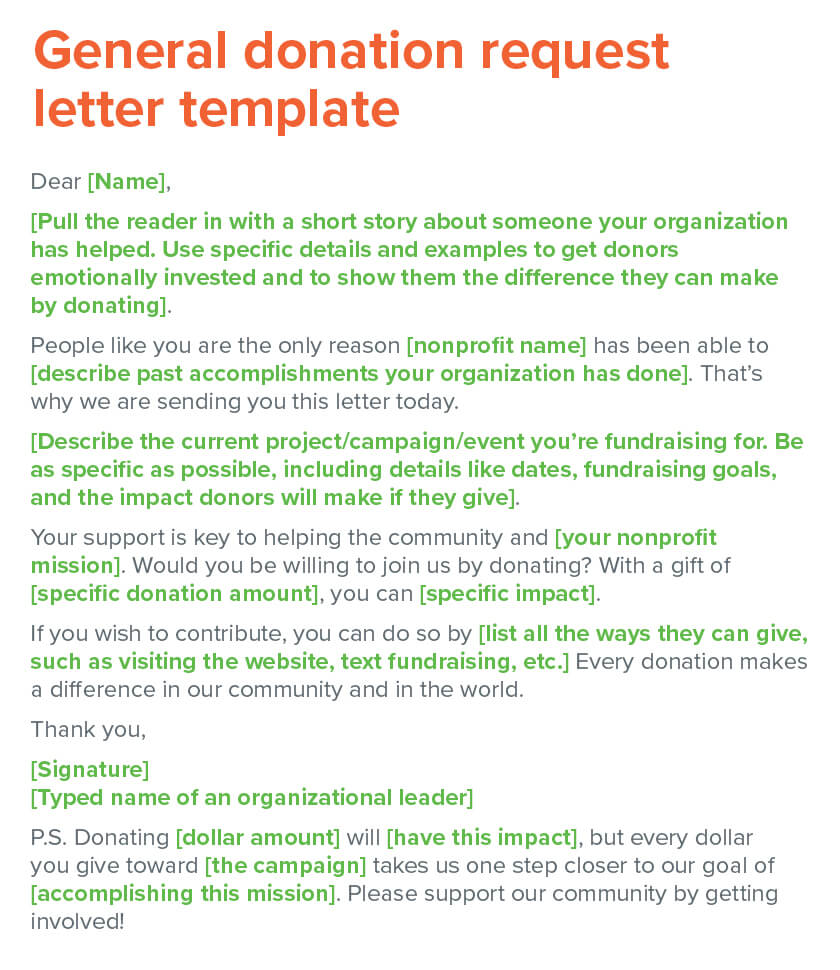
Crisis donation request letter
What is a crisis donation request letter?
Crises like pandemics, economic downturns, and political conflicts make nonprofit missions even more essential as organizations like yours seek to help those impacted.
Writing donation letters during times of crisis and instability may seem daunting. When approaching delicate topics like this, your best bet is to acknowledge it immediately and let your donors know you understand their situation. Ultimately, it’s important to remember that these letters should be donor-centric and focus on connecting donors to the people they’ll help.
To whom should you send crisis donation request letters?
Amid economic uncertainty, it’s helpful to send donation request letters to your wealthiest donors, who often have the means to weather economic downturns. However, there are plenty of ways to help in a crisis that don’t involve direct donations, so don’t discount everyday donors and volunteers when sending these letters.
Crisis donation request letter template
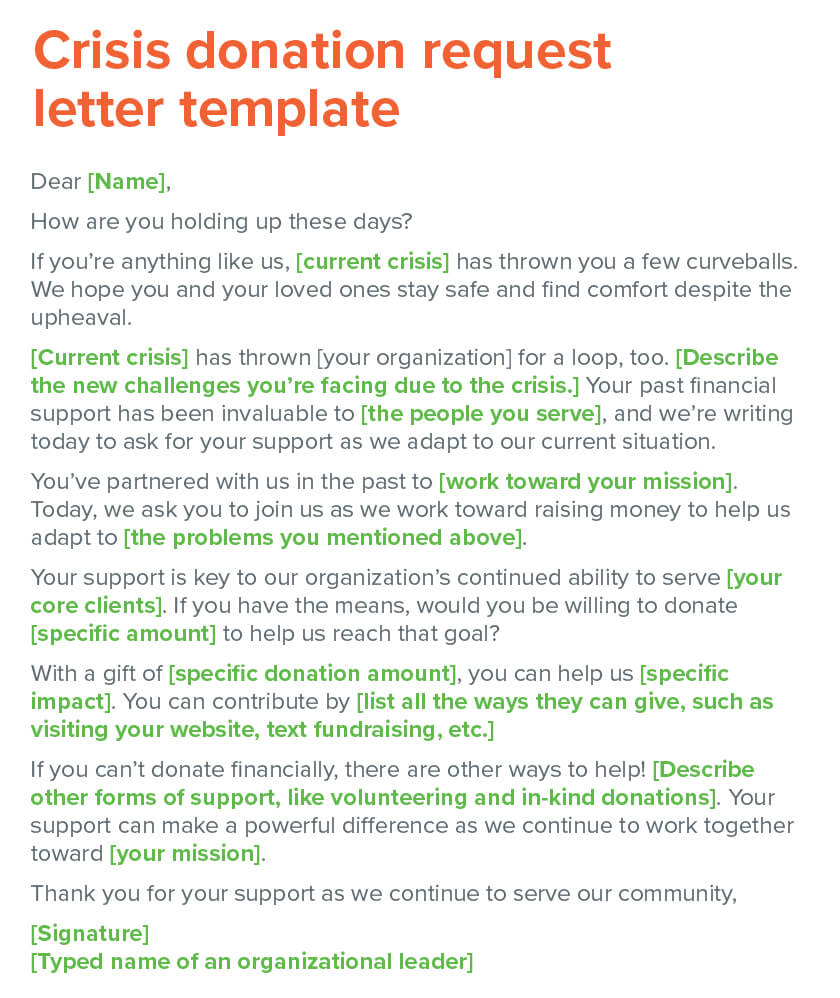
Individual sponsorship request letter
What is an individual sponsorship request letter?
Sponsorship letters are similar to standard fundraising letters. The only difference is that sponsorships are usually tied to events like marathons, walkathons, bikeathons, and fun runs.
The sponsorship request might also have a reward or incentive attached, such as:
- The sponsor’s name is included in promotional items and advertising materials.
- Certain merchandise related to the event.
- Seats or tickets to the event.
If you really want to impress potential sponsors, ask them what incentives they’d like before sending the appeal. They may have ideas you’ve never considered!
To whom should you send individual sponsorship request letters?
Past event sponsors, mid-level and major donors, and local business owners or entrepreneurs are great places to start when searching for sponsors.
Individual sponsorship request template

Corporate donation request letter
What is a corporate donation request letter?
Rather than asking for an individual donation, corporate donation request letters are sent to companies to secure business sponsorships.
Note that this corporate sponsorship letter asks for an in-person meeting with the organization’s leader. The company you’re writing to may hesitate to give money to a nonprofit they’ve never worked with. In-person meetings are a good move even with organizations that have supported you in the past—most major donors prefer to handle their philanthropic conversations in person. That includes corporations and other businesses!
An in-person meeting can greatly help your fundraising efforts. It allows the business leader to ask questions, express concerns, and become more familiar with your organization—and with you! Donors prefer to give to people rather than organizations, even if they’re part of a big company. Your face-to-face meeting will make them much more likely to give.
A corporate sponsorship request might also have rewards and incentives such as:
- Brand exposure: Logo placement on promotional materials, event signage, and advertising campaigns, increasing brand visibility.
- Networking opportunities: Exclusive access to networking events, galas, or conferences hosted by the nonprofit, fostering connections with industry leaders.
- VIP treatment: Reserved seating or VIP tickets to nonprofit events, offering an elevated experience for sponsors.
- Recognition and appreciation: Public acknowledgment during speeches, presentations, or award ceremonies at nonprofit events, highlighting the sponsor’s contribution.
- Branding opportunities: Opportunities for brand integration or product placement at nonprofit events, enhancing brand exposure.
- Corporate Social Responsibility (CSR) initiatives: Participation in volunteer opportunities, community service projects, or philanthropic initiatives that align with the sponsor’s CSR goals.
- Customized packages: Tailored sponsorship packages designed to meet specific marketing objectives and budgetary constraints, maximizing value for sponsors.
Similar to your individual sponsorship requests, you can ask corporate sponsors for their preferred incentives in your in-person meetings.
To whom should you send corporate donation request letters?
Start by contacting leaders or corporate social responsibility coordinators at local businesses in your area. Contact both businesses you’ve worked with in the past and prospective businesses you think could be a good match for your sponsorship opportunities.
Corporate donation request template

Volunteer time request letter
What is a volunteer time request letter?
A volunteer request letter should focus on the work a volunteer might do if they choose to work with your organization. It should also explain how their work will positively impact the people or community you support.
Volunteers will be more familiar with your organization if they’ve been involved in the past. If you’re writing a letter to someone with a history of volunteering with your organization or other nonprofits, you should reference that involvement and thank them for their service.
To whom should you send volunteer time request letters?
Volunteers can arise in the most unexpected places, so cast a wide net when sending volunteer time request letters. Current and past volunteers and donors, board members, peer-to-peer fundraisers, social media followers, and local businesses can all be effective sources of volunteer support.
Volunteer time request letter template
Peer-to-peer fundraising donation request letter
What is a peer-to-peer fundraising donation request letter?
Peer-to-peer fundraising campaigns are one of the most effective ways for your nonprofit to raise money and spread the word about your mission online. Your supporters will launch personalized fundraising pages for your cause and then reach out to their personal networks to solicit gifts from their personal networks.
Provide your peer-to-peer fundraising participants with a template like this to show them how to solicit these gifts. By filling in the blanks, they can easily craft effective and personalized solicitations.
When your participants sign up and start designing their fundraising page, consider providing fundraising templates like this one to help them get started. With Qgiv, these are easy to create! You can include them in your participants’ fundraising dashboards, giving them instant access to the email section of their sharing tools.
To whom should you send peer-to-peer fundraising donation request letters?
Encourage peer-to-peer participants to reach out to a broad audience of friends, family members, neighbors, and coworkers.
Peer-to-peer fundraising donation request template

Matching gift donation request letter
What is a matching gift donation request letter?
It’s rare for all of your supporters to know what matching gift programs are or if their employers offer matching gifts. This is why your nonprofit should plan to send matching gift fundraising letters with supplemental information to recent donors. These letters can outline how to check eligibility and send in a matching gift request to complete the process.
As you prepare to send your letters, use a matching gift database to determine which donors qualify for a matching gift. Then, create a donor segment list of these special supporters in your CRM.
Additionally, be sure to highlight that submitting this request will not require any further giving on their part. Submitting this request is the best way for supporters to maximize the impact of their original gift and is essentially free money for your cause.
To whom should you send matching gift donation request letters?
Send these letters to donors who contributed to your organization but haven’t yet submitted a matching gift via their employers.
Matching gift donation request template
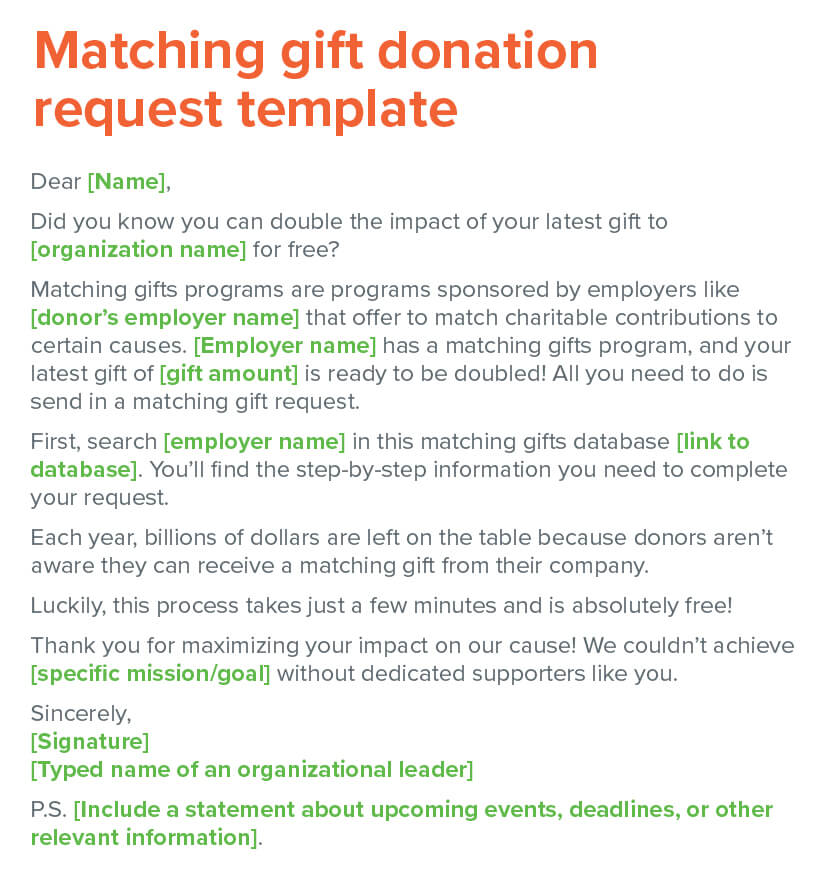
School fundraising letter
What is a school fundraising letter?
Schools generally have an incredibly wide range of constituents. This is why it’s so important that schools take their fundraising needs seriously and plan ahead for how they’ll request contributions from community members.
To make your school’s fundraising efforts more effective, create templates for different fundraising letters based on the type of supporter you’re addressing. Perhaps you’re soliciting a gift from a parent of a current student—address them accordingly! Alternatively, you might want to draft a solicitation template addressed to an alumnus.
When creating your school fundraising letter template, your nonprofit should emphasize your school’s impact on its current students and the next generation of your community.
To whom should you send school fundraising letters?
Send these donation requests to students’ parents, families, school alumni, board members, and other members of your community who have engaged with your school in the past.
School fundraising letter template

Church fundraising letter
What is a church fundraising letter?
Churches raise funds for various reasons, from funding community outreach programs like food banks to supporting international trips. In your church fundraising letters, be sure to put your congregation’s mission first and foremost. You’ll want to immediately address congregants’ sense of commitment to your church and make the most of the existing relationship with this individual.
Your reader may already make collection plate gifts each Sunday, so you’ll need to make the case for them to make a more targeted gift outside these offerings. Be sure to tell them exactly how much you need to raise and how that funding will be used.
To whom should you send church fundraising letters?
Send these fundraising letters to congregants who have contributed in the past and those who have yet to make a larger donation (outside of collection plate offerings).
Church fundraising letter template
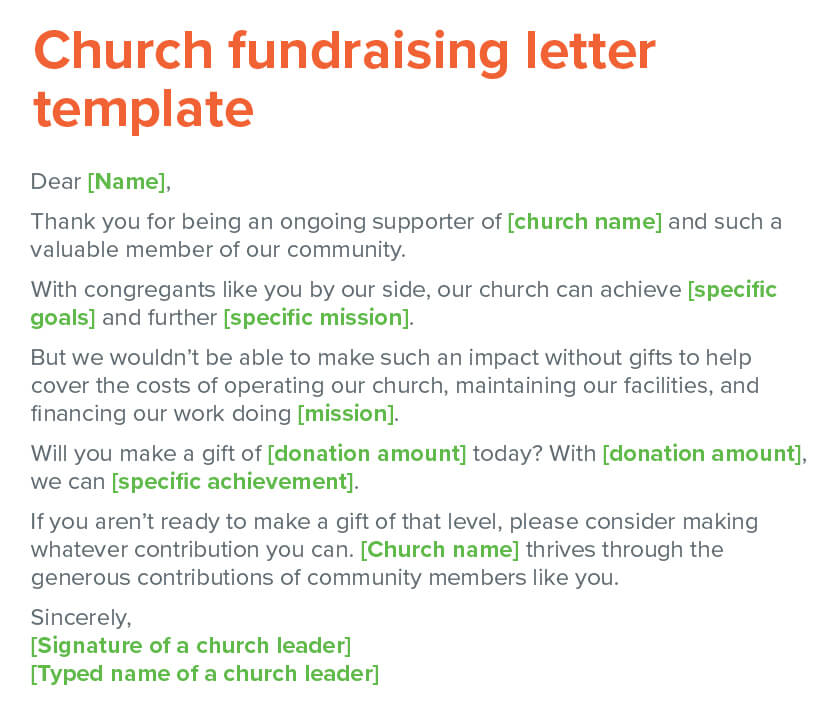
Animal rescue donation letter
What is an animal rescue donation letter?
Animal rescue organizations serve an important role in your community, and you can share the importance of your work when writing a fundraising letter. Additionally, you can tap into your readers’ emotional connection to animals to make the case for why they should give back.
In your letter, consider sharing an image of real-life animals saved by your rescue. Include a caption with the pet’s name and age as an added way to pull at your supporters’ heartstrings. After they donate, send a thank-you letter with a follow-up message about these pets to emphasize the impact of their donation.
To whom should you send animal rescue donation letters?
Your animal rescue should send tailored letters to different groups in your community. These could include individuals who adopted pets from your rescue, volunteers, or helpful community members who have dropped off lost or stray animals at your shelter.
Animal rescue donation letter template

Auction item donation request letter
What is an auction item donation request letter?
Auctions are great opportunities to raise significant funds for your organization, but procuring auction items can be tricky. Your goal should be to procure appealing items that encourage attendees to bid. Be sure to share the types of auction items or experiences you’re looking for so donors understand what you need.
You can send these fundraising letters to local businesses and other supporters. Explain what the proceeds will go toward.
To whom should you send auction item donation request letters?
Individual donors and corporate sponsors may have the means and motivation to give to your auction, so send these letters widely. Make these requests to both past sponsors and potential new sponsors.
Auction item donation request template

Donation thank-you letter
What is a donation thank-you letter?
If your initial fundraising letter is successful and a supporter gives to your cause or participates in an event, you must show your appreciation with an acknowledgment letter. Without your donors, your organization could not develop important programs and fund life-changing projects that impact your cause.
Sending acknowledgment letters does more than just thank your supporters! It also helps promote a healthy and positive relationship between your organization and donors, setting up a solid foundation for future engagement. Remember to send your letter soon after the donation so the engagement is fresh in the donor’s mind.
To whom should you send donation thank-you letters?
Answer every donation you receive with a heartfelt thank-you letter expressing your organization’s gratitude. After all, without the support from your donors, your organization wouldn’t be able to make the meaningful difference it has.
Donation thank-you letter template
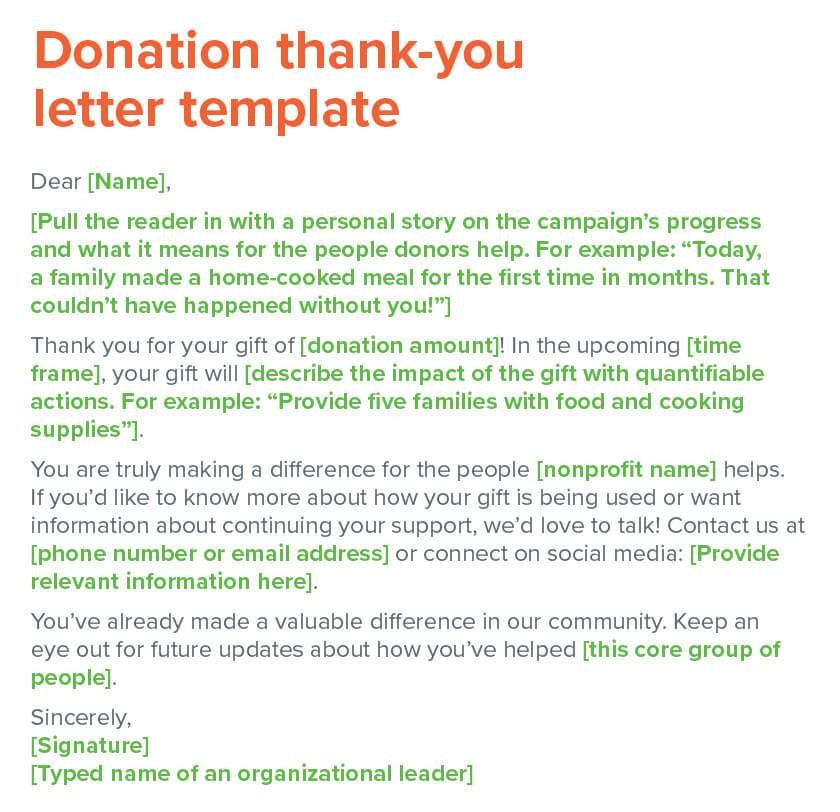
Final thoughts
Your donation letters have one primary purpose: to inspire donors to give. But a great donation letter does more! Following these donation letter best practices lays the foundation for future engagement. Sending an engaging, inspiring donation letter gives you the opportunity to get to know your supporters better and build long-lasting relationships.
Sending donation request letters, building inspiring donation forms, and forming lifelong donor connections are easier with the help of a robust fundraising platform like Qgiv by Bloomerang. With this unified solution, your organization can:
- Build an unlimited number of customizable donation forms.
- Send donation requests via email and texts.
- Manage auction events, from item procurement to bidding and checkout.
- Track donor engagement metrics, including communication preferences, donor retention, and likelihood of giving.
- Integrate with the other software solutions your organization already has.
Ready to see what this easy-to-use fundraising platform can do for your cause? Schedule a demo today for a personalized look at how Qgiv by Bloomerang simplifies and maximizes fundraising.
Additional resources
Check out these additional resources for more donation appeal templates!
- Donor Appreciation Email Templates: Showing donors you genuinely appreciate them can strengthen connection and loyalty. Use these donor appreciation email templates to make the work easier.
- Peer-to-Peer Fundraising Email Templates: Effective communication is one of the best ways to inspire your peer-to-peer participants. Keeping your supporters motivated with these peer-to-peer fundraising email templates and tips is simple.
- Text Message Templates for Nonprofits: Here’s a collection of handy templates for thank-you texts, impact messages, volunteer appeals, event reminders, and more!
- Interactive Donation Form Templates: The layout of your donation form has a major impact on donor conversion rates! Should you use a multistep layout to break up the process? Is a single-step form the best answer? These interactive donation form templates will help you decide!







